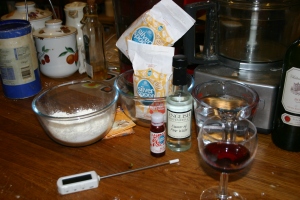I got assessed today. I’ve managed to get from first GP appointment to full assessment in just over 6 months, which by all accounts seems to be pretty good going.
I have fretted about the assessment A LOT. The letter said the assessment would take around 3 hours, but I had no idea what form the assessment would take – interviews, tests, with my mum in the room, without my mum in the room – no idea. This is a bad thing for me: I like to know what’s coming and I had never had a psychiatric assessment before, which was pretty unsettling in itself.
On top of that, I was worried that I would get told at the end of it either:
a.) You don’t have Asperger’s. You’re just a weirdo, and moreover, you’re making a fuss out of nothing. Get a grip. (Note: this would never happen. Just my own personal worry!)
b.) You don’t have Asperger’s. You probably have something else. You know this stressful assessment process? You’re going to have to go through it all again for a condition you’re not even familiar with. Enjoy.
Now in asking around, what I have learned is that no two assessment centres are the same. Every place has a different way of approaching the assessment. So if you’re hoping to get the definitive answer on what your own assessment will be like – THIS ISN’T IT. This is just what my assessment was like, at the Cambridge Lifespan Asperger Syndrome Service. It might be different for you even if you get assessed at the same place. If you are worried, call or write to the centre. If you get fobbed off by a receptionist, don’t stand for it, insist on having one of the clinicians write back to you. I brought this up at my assessment and this is what the psychiatrist recommended. You will not be considered rude for doing so.
The assessment was actually a three hour interview with me and my mum. That sounds really intimidating doesn’t it? It wasn’t. The lady was friendly, direct and approachable. She respected my need to take time to answer questions. I got a bit stressed and upset partway through – she just gave me breathing time to stop before carrying on.
The interview essentially went through the DSM criteria (You can see a full list of them on my earlier post here). She asked questions about my behaviour now, and as a child in relation to those main criteria. Look at the criteria, consider ways in which they relate to you. If you’re worried you don’t know – don’t worry, your clinician will question you in ways that allow them to find out what they need to know. The onus is on them, not you – this advice is only if you wish to feel a little more prepared for what you may be asked. The only thing that I do recommend you consider (and to be honest, *should* have done if you’re putting yourself forward for this) – you will get asked what has brought you there to be assessed as an adult. You’ll probably have thought about this a lot and you’ll want to consider what your answer will be. Knowing a good answer to the first question made me a lot more relaxed about the rest of it.
I don’t know if other centres do it differently, but mine gave me a diagnosis verbally at the end. She gave a description of what brought her to the conclusion, and some advice in the short term for things that might help with meltdowns and panic attacks. I’ll get a written report in a couple of weeks and so will my GP.
The conclusion of all this?
I am that unusual beast, the woman with Asperger’s. I am variously described as representing less than 1 in 4 of diagnosed Aspies, or as close to a 1:1.5 ratio. What does seem fairly certain is that the medical community is getting better and better at recognising the differences between males and females with Asperger’s, and are getting better at spotting it in women. Our symptoms present a little differently, and we may hide our social difficulties more easily, and may be better behaved as children than our male counterparts, but we exist.
Next steps
This point might be the end of the line for some people, but I see the assessment as a means to an end. In my case, the diagnostic centre does not offer ongoing care, only a diagnosis. So to get help with panic, anxiety and meltdowns I need to go back to my GP (yes, the one who said I couldn’t have Asperger’s because I looked ‘pretty normal’… may try and swap GP). From there I should be connected up to any relevant services to help me. As and when there is anything to report on what those services might be and what they are like, I’ll write it up on here. I really have no idea yet.
One more thing
An assessment will not change who I am. It does not excuse bad behaviour. It does not give me free licence to act like a jerk and say it’s because I am autistic. It is a tool. It is a means to politely ask for help and resources when you might not otherwise be able to get them. It is a means to ask for assistance and understanding when you are acting in a way that other people think of as weird or irrational. It is a way to explain and understand yourself. It is a way to get help. It is not a quick fix, or a magic wand either – from here, this is going to require some hard work and re-conditioning and that all has to come from me. If help is what you want – don’t expect it to be easy.
Then again, if you met me, you probably wouldn’t pick me out as terribly different (my friends might disagree). I am geeky, over-talkative, sometimes a little insensitive, but I am also caring, and perfectly capable of living independently. Asperger’s does not pick me out as too much weirder than your average nerd. Most of what happens with Asperger’s is on the inside – it’s how *I* feel, and how *I* understand the world, not how I present to the rest of it (although that’s part of it). It is a spectrum, and lots of people are much further along it than me. They may be more noticeably ‘different’. The only point I wish to make here is that not everyone you meet with Asperger’s is like Rain Man. Most of us are just geeks, and most of us just want life to be a little easier.
So that’s it – Asperger’s assessment from start to finish. Feel free to ask any questions in the comments, I’m happy to (try to) answer anything I can help with.
Part 1: On Asperger’s Syndrome and Getting a Diagnosis
Part 2: Getting a GP Appointment
Part 3: Waiting… lots of waiting
















